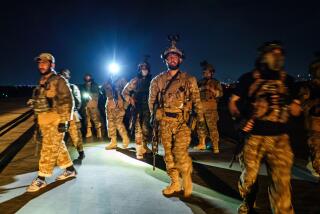One Keeps Launcher Safe at Hand : Afghan Rebels Buoyed by Accuracy of U.S. Stingers
- Share via
PESHAWAR, Pakistan — One of his men, the Afghan rebel commander said, is so fond of his new Stinger missile launcher that he spends most of his waking time polishing it and sleeps with it next to him.
“When it rains,” the commander said, “he takes the shawl off his back and covers the Stinger.”
He said the man has fired his weapon only seven times but has brought down five Soviet aircraft in Afghanistan--two helicopters and three transport planes.
The rebel commander asked not to be identified by name because, officially, the 90,000 or so moujahedeen fighting the 115,000 Soviet troops and the Soviet-backed forces of the Afghan government do not have Stinger missiles.
Like the several hundred million dollars in conventional weaponry that comes to the rebels every year through Pakistan, the Stingers are part of the largest covert operation by the CIA since the war in Vietnam.
U.S. diplomats in Islamabad, when pressed to discuss such matters, refer with tongue in cheek to the “weapons we do not supply the moujahedeen.” Of all the weapons, the Stinger is the most sensitive subject.
Nevertheless, diplomatic and Afghan rebel sources confide that since it was first supplied to two rebel units in October, the Stinger has done more to improve the rebels’ fighting efficiency than any other weapon. According to rebel commanders here in Peshawar, headquarters for many of the moujahedeen groups, the $60,000 Stinger has an unprecedented kill rate of 70%.
This means that seven out of 10 times the missile is fired at a flying target, the target is destroyed. Partly because of the Stinger, the Afghan rebels are now bringing down an average of one Soviet or Afghan aircraft a day, according to a statement made recently by a State Department spokesman in Washington.
Some Afghan military analysts contend that the Stinger, made by General Dynamics in Pomona, Calif., is partly responsible for recent peace initiatives put forth by the Soviet-backed government in Kabul, the Afghan capital.
‘It Has Helped’
“I don’t think it was a huge factor,” a Western military source in Islamabad said, “but I am sure it has helped move them more quickly toward some kind of settlement.”
Not long ago, officials in Kabul showed visiting Western journalists what they said was a confiscated Stinger, and they made it clear that they had learned to respect it.
“We know the bandit groups that have them,” one official said, “and we are trying to wipe them out.”
The Stinger is by far the most modern item in the rebel arsenal, which still includes Enfield rifles that date back to World War I. It is a shoulder-fired, surface-to-air missile that weighs a little more than 30 pounds and is a significant advance over other anti-aircraft weapons used by the moujahedeen.
“The Stinger gives you greater range and better angles,” a Western military source said. “You can even use it effectively when the aircraft is coming directly at you.”
Distraction Avoidance
Like other anti-aircraft missiles, including the U.S.-made Redeye and the Soviet SAM-7, known as the Grail, the Stinger operates on a passive infrared homing system. But unlike the other weapons, the Stinger can avoid being “distracted” by other sources of heat near the target aircraft.
This is particularly important in Afghanistan, where Soviet and Afghan flight crews customarily drop heat-generating flares as they enter a combat zone. Also, the most effective and feared Soviet helicopter, the MI-24 Hind, is equipped with engine exhaust suppressors to confuse heat-seeking missiles.
Such devices were also used by American aircraft in Vietnam, to avoid SAM-7s fired by the North Vietnamese, and by the Israelis in the Arab-Israeli War of 1973. During that war, according to military analysts, the Syrians and Egyptians fired 5,000 SAM-7 missiles at Israeli craft but destroyed only four and damaged 28.
In light of this experience, the Stinger’s reported performance in Afghanistan is all the more remarkable and may have broad implications for other conflicts involving ground forces subjected to aerial attack.
The Stinger is currently in service with the U.S. Army, Air Force and Marine Corps. It is also in service in, or has been ordered by, Chad, Italy, Japan, the Netherlands, Saudi Arabia, Turkey, Britain, West Germany and Pakistan.
While Secretary of Defense Caspar W. Weinberger was in Pakistan in October, U.S. officials said that 120 Stinger missile units had been delivered to Pakistan. But according to sources in Islamabad, the capital of Pakistan, the Pakistani army has had much less luck with the Stinger than have the ragtag Afghan rebels.
According to one Western source, Pakistanis have fired Stingers 16 times at Soviet and Afghan aircraft that strayed into their airspace but all 16 efforts failed, partly because the range was excessive.
At first, Pakistani military officers who trained the Afghan rebels with the Stinger were reluctant to allow the weapon into Afghanistan, mainly because they feared that the Soviet Union might consider it an escalation of the fighting and partly because they feared that the weapon might be too sophisticated for the mostly illiterate moujahedeen. The operator of the battery-powered Stinger must perform several technical functions to arm and fire the missile after he has a target in sight.
Early last fall, the Washington Post reported that some Stingers had been allowed into Afghanistan but then ordered withdrawn by Pakistani authorities after minor technical failures.
Stingers Reassigned
The Stingers were then carefully reassigned to rebel units that had proved their ability with SAM-7s supplied through the CIA pipeline. The main recipients of the Stinger were the Hezbi-i-Islami Khalis organization, headed by Younis Khalis, and the Hezbi-i-Islami Hekmatyar, headed by Gulbuddin Hekmatyar.
By November, the State Department was reporting that the rebels were bringing down one enemy aircraft a day, a marked increase in efficiency.
A commander with one unit using the Stinger says he has detected a radical change in tactics by Soviet pilots, particularly pilots of the MI-24 gunship that had been so effective against the rebels.
“Before,” the commander said, “the helicopters would come and hover over our positions. They were really hurting us. Now they come in quickly and move out quickly.”
Although no more than a few dozen Stinger units have been distributed to the rebels, their reputation for accuracy and deadliness has increased their effectiveness far beyond their number.
The rebel commander interviewed in Peshawar said his men have monitored radio communications and overheard Soviet pilots talking about the Stinger.
When the rebels depended on the SAM-7 or heavy machine guns, they were often unable to disable an aircraft even with direct hits. The MI-24 is so heavily armored that it can deflect the SAM-7.
“But with the Stinger,” the commander said, “if you hit the target, it is gone.”
More to Read
Sign up for Essential California
The most important California stories and recommendations in your inbox every morning.
You may occasionally receive promotional content from the Los Angeles Times.













